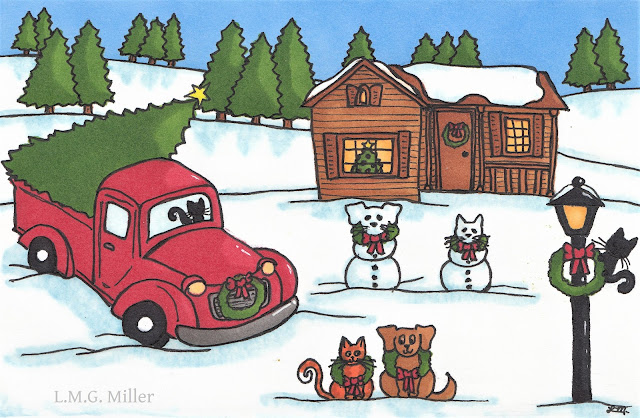Pup Astrid has shown you all before how cute she is in her festive sweater, and how much she loves snow. Today, she has a sequel of both of those facts.
***
Festive Flashback Doodle of the Day
***
Tip of the Day
Something that comes along with offering outdoor ferals and strays shelter, which we discussed yesterday, is warmth. There are a great many considerations to make when it comes to offering warmth to ferals on cold winter days. We'll start with considering the size of the space the cat will be occupying, such as the size of the shelter you have for ferals and strays, as that affects how heat is trapped. Shelters should of course be large enough to fit one or a couple cats, or even a few cats if you care for that many that get along. At the same time, though, the shelter should be small enough that cold air does not easily circulate throughout it. A shelter that is not too large will better trap and insulate heat. Another consideration to make when it comes to the shelter's construction and heat retention is the doorway. Though you don't want to block entry or exit or make ferals feel trapped inside a shelter, try your best to block drafts from entering through doorways. If possible, keep entrances faced away from the wind and drafts, such as by facing the doorways toward a wall of your house or other structure, so that the shelter's entrance won't directly face open air.
In addition to the warmth that a shelter itself can offer, there are more direct heat sources that can be put out for ferals and strays. One simple option includes heating pads or beds that do not directly produce heat themselves, but that instead contain material that allows the bed to radiate heat. There are beds on the market that are said to warm to approximately the animal's body temperature when they are lying on it. There are also electric heating pads and heated beds that do indeed produce heat, allowing for immediate access to a warm place to sleep. Of course, always be cautious and aware of the dangers of burns and fires when electricity and heat comes into play, and go the safest route possible. That being said, also keep in mind that any bedding made with fabric, whether heated or not, can become and remain wet as well as dirty, and therefore can prevent a cat from wanting to use it. For more information on bedding material in an outdoor shelter, visit us for tomorrow's tip.
All of the above being said, you can also go for heating lamps or some form of space heater to use inside an outdoor cat shelter. This is of course yet another option you have to research, though, to ensure that you get one that is safe for outdoor use, and that will be the most practical to prevent burns, fires, and so forth. All in all, when it comes to providing heating sources for outdoor ferals and strays, do your research and take all precautions possible. Always be aware of the dangers of burns or fires when it comes to electricity and heat, and choose and use heating sources accordingly and wisely.
In addition to the warmth that a shelter itself can offer, there are more direct heat sources that can be put out for ferals and strays. One simple option includes heating pads or beds that do not directly produce heat themselves, but that instead contain material that allows the bed to radiate heat. There are beds on the market that are said to warm to approximately the animal's body temperature when they are lying on it. There are also electric heating pads and heated beds that do indeed produce heat, allowing for immediate access to a warm place to sleep. Of course, always be cautious and aware of the dangers of burns and fires when electricity and heat comes into play, and go the safest route possible. That being said, also keep in mind that any bedding made with fabric, whether heated or not, can become and remain wet as well as dirty, and therefore can prevent a cat from wanting to use it. For more information on bedding material in an outdoor shelter, visit us for tomorrow's tip.
All of the above being said, you can also go for heating lamps or some form of space heater to use inside an outdoor cat shelter. This is of course yet another option you have to research, though, to ensure that you get one that is safe for outdoor use, and that will be the most practical to prevent burns, fires, and so forth. All in all, when it comes to providing heating sources for outdoor ferals and strays, do your research and take all precautions possible. Always be aware of the dangers of burns or fires when it comes to electricity and heat, and choose and use heating sources accordingly and wisely.





4 comments:
That's a cute sweater, Astrid.
We have snow coming this weekend. You look so pretty in your sweater Astrid. Nice drawing and great tips. XO
I just love seeing dogs in sweaters :) So cute!
Mama, mama, it's snow! Don't make me slow down, it's snow!!!
Post a Comment